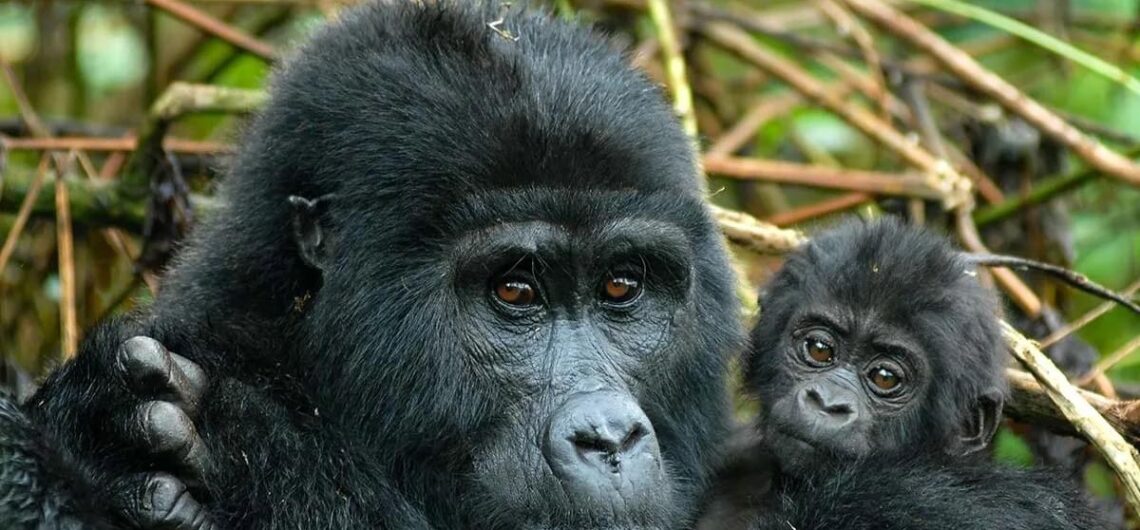The gorilla tracking adventure presents explorers with the golden opportunity to wander through the protected primeval, blooming forests in Uganda. Visitors get the chance to spend time with wildlife species and listen to the sounds of nature, a perfect getaway from the usual noise and chaos of the bustling cities.
Travelers have the golden opportunity to encounter a section of the world’s only remaining mountain gorillas in their natural habitat. Spend time with them, watch them live their untroubled lives.
Description of the gorilla national parks in Uganda.
Uganda has two distinct habitats hosting mountain gorillas. They have similar characteristics but also showcase differences in terms of natural endowments and the population of gorillas they host. The two gorilla national parks incorporate;
Bwindi Impenetrable National Park.
Bwindi lies in the southwest of Uganda in the present-day Kanungu district. The Bwindi forest covers an area of up to 331 square kilometers. This captivating national park hosts Africa’s oldest tropical rainforest which further makes it a perfect home for the gentle giants. Bwindi is a renowned UNESCO World Heritage site due to the exceptional biodiversity it’s associated with. Bwindi Impenetrable National Park has four gorilla trekking sectors hosting 21 fully habituated gorilla families.
A trek through Bwindi leaves you excited and makes you appreciate nature more because it has a lot to feed your eyes. From the breathtaking towering rainforests to the calm demeanor of mountain gorillas. Bwindi is indeed the place to be for every nature enthusiast.
Mgahinga National Park.
Mgahinga on the other hand is also a gorilla National Park in Uganda hosting one gorilla family. The gorilla family is called Nyakagezi and comprises nine welcoming members. Visitors enjoy the time spent with the family mainly because of its organization and the cooperation among the individuals. Most of the visitors to this gorilla family cannot get over the calm character of the gorillas and how they coexist. The playful juveniles even make the trek to the family more exciting.
Mgahinga National Park spans an area of about 33.7 square kilometers comprising breathtaking volcanoes. What is so fascinating about this National Park is that it is the smallest country yet it hosts some of the most exciting tourist activities one can indulge in when in Uganda and gives equally breathtaking views that are associated with the extinct volcanoes therein.
How gorilla trekking is done, what it costs, and what to see.
Gorilla trekking activities are kick-started early morning with a briefing with the park officials that helps the guests scoop information on what to do and what to stay away from when on the trek. Guests are told what to do when they are close to the gentle giants to maintain harmony.
The trek is done under the full-time company of the National Park Rangers who ensure that it is peaceful for both the mountain gorillas and the trekkers. The trek could go on for about 7 to 8 hours depending on the location of the gorilla family to be trekked and the speed of the trekkers.
For the opportunity to trek gorillas, one is required to present a valid permit to the authorities just before they are allowed to access them. The permits are purchased through registered tour operators at $700.00 for foreign nonresidents, $600.00 for foreign residents, and Uganda shillings 250,000 for East African citizens.
Accessing the national parks.
The gorilla national parks in Uganda can be accessed by major road transport though air transport can also be used.
To access Bwindi Impenetrable National Park, visitors can drive on the Kampala – Mbarara – Kanungu road which usually takes about 10 hours for the 501.4 kilometre distance.
To access Mgahinga National Park, visitors can also use the same road. Though they will continue up to Kisoro. The journey consumes 10 to 11 hours.
When to visit.
Visitors can always access the park at all times of the year although the most preferred moments are during the dry months that is to say from early June to September and December all through to February.


Comments